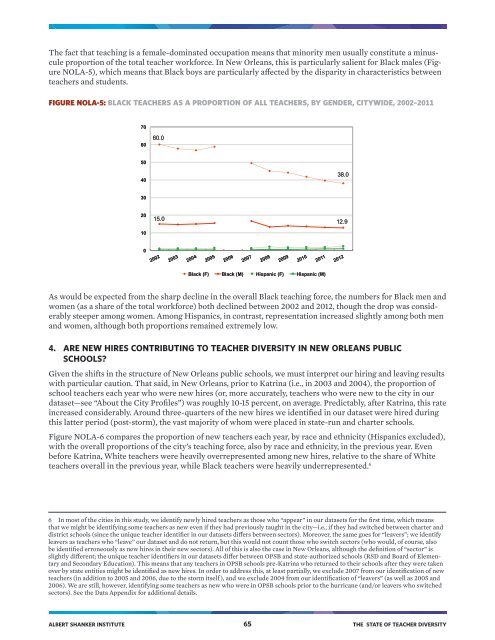TEACHER DIVERSITY
The State of Teacher Diversity_0
The State of Teacher Diversity_0
- No tags were found...
You also want an ePaper? Increase the reach of your titles
YUMPU automatically turns print PDFs into web optimized ePapers that Google loves.
The fact that teaching is a female-dominated occupation means that minority men usually constitute a minuscule<br />
proportion of the total teacher workforce. In New Orleans, this is particularly salient for Black males (Figure<br />
NOLA-5), which means that Black boys are particularly affected by the disparity in characteristics between<br />
teachers and students.<br />
FIGURE NOLA-5: BLACK <strong>TEACHER</strong>S AS A PROPORTION OF ALL <strong>TEACHER</strong>S, BY GENDER, CITYWIDE, 2002–2011<br />
70<br />
60<br />
60.0<br />
50<br />
40<br />
38.0<br />
30<br />
20<br />
10<br />
15.0<br />
12.9<br />
0<br />
Black (F) Black (M) Hispanic (F) Hispanic (M)<br />
As would be expected from the sharp decline in the overall Black teaching force, the numbers for Black men and<br />
women (as a share of the total workforce) both declined between 2002 and 2012, though the drop was considerably<br />
steeper among women. Among Hispanics, in contrast, representation increased slightly among both men<br />
and women, although both proportions remained extremely low.<br />
4. ARE NEW HIRES CONTRIBUTING TO <strong>TEACHER</strong> <strong>DIVERSITY</strong> IN NEW ORLEANS PUBLIC<br />
SCHOOLS?<br />
Given the shifts in the structure of New Orleans public schools, we must interpret our hiring and leaving results<br />
with particular caution. That said, in New Orleans, prior to Katrina (i.e., in 2003 and 2004), the proportion of<br />
school teachers each year who were new hires (or, more accurately, teachers who were new to the city in our<br />
dataset—see “About the City Profiles”) was roughly 10-15 percent, on average. Predictably, after Katrina, this rate<br />
increased considerably. Around three-quarters of the new hires we identified in our dataset were hired during<br />
this latter period (post-storm), the vast majority of whom were placed in state-run and charter schools.<br />
Figure NOLA-6 compares the proportion of new teachers each year, by race and ethnicity (Hispanics excluded),<br />
with the overall proportions of the city’s teaching force, also by race and ethnicity, in the previous year. Even<br />
before Katrina, White teachers were heavily overrepresented among new hires, relative to the share of White<br />
teachers overall in the previous year, while Black teachers were heavily underrepresented. 6<br />
6 In most of the cities in this study, we identify newly hired teachers as those who “appear” in our datasets for the first time, which means<br />
that we might be identifying some teachers as new even if they had previously taught in the city—i.e., if they had switched between charter and<br />
district schools (since the unique teacher identifier in our datasets differs between sectors). Moreover, the same goes for “leavers”; we identify<br />
leavers as teachers who “leave” our dataset and do not return, but this would not count those who switch sectors (who would, of course, also<br />
be identified erroneously as new hires in their new sectors). All of this is also the case in New Orleans, although the definition of “sector” is<br />
slightly different; the unique teacher identifiers in our datasets differ between OPSB and state-authorized schools (RSD and Board of Elementary<br />
and Secondary Education). This means that any teachers in OPSB schools pre-Katrina who returned to their schools after they were taken<br />
over by state entities might be identified as new hires. In order to address this, at least partially, we exclude 2007 from our identification of new<br />
teachers (in addition to 2005 and 2006, due to the storm itself ), and we exclude 2004 from our identification of “leavers” (as well as 2005 and<br />
2006). We are still, however, identifying some teachers as new who were in OPSB schools prior to the hurricane (and/or leavers who switched<br />
sectors). See the Data Appendix for additional details.<br />
ALBERT SHANKER INSTITUTE 65 THE STATE OF <strong>TEACHER</strong> <strong>DIVERSITY</strong>


